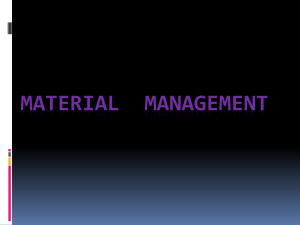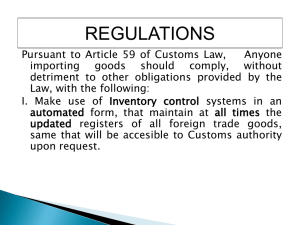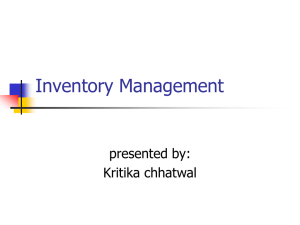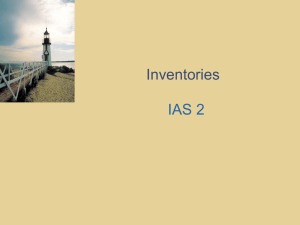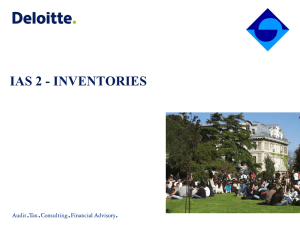Chapter 7
advertisement
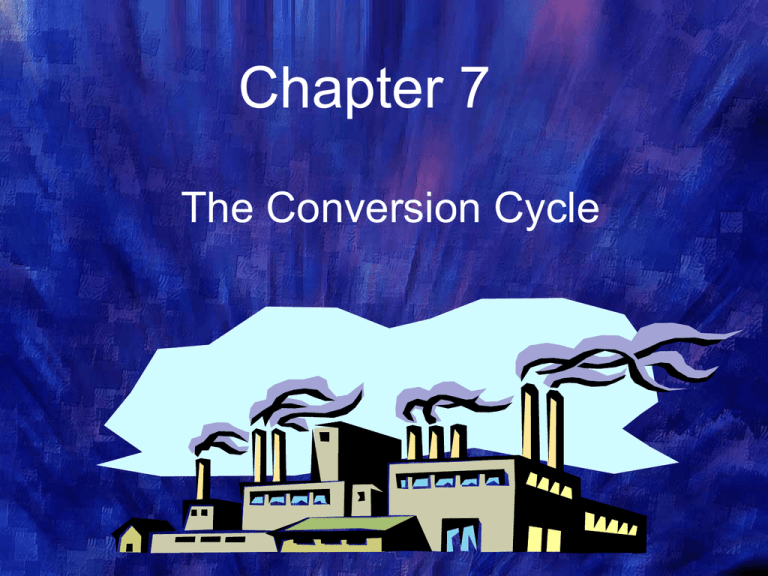
Chapter 7 The Conversion Cycle Objectives for Chapter 7 • Elements and procedures of a traditional production process • Data flows and procedures in a traditional cost accounting system • Accounting controls in a traditional environment • Operating features, philosophies, and technologies of a world-class company • Just-in-time systems and the implications of maintaining excessive inventories in the world-class environment • Importance of quality in the world-class environment • Shortcomings of traditional accounting methods in the worldclass environment • Characteristics of a world-class information system The Continuum of Manufacturing Practices A World Class Company… • is a company that has achieved high standards and has undergone fundamental changes from traditional forms of organization and management • continuously pursues improvement in all aspects of its operations, including its manufacturing procedures • is highly customer oriented Achieving World-Class Status • The world-class firm needs new accounting methods and new information systems that: – – – – show what matters to its customers identify profitable products identify profitable customers identify opportunities for improvement in operations and products – encourage the adoption of value-added activities and processes within the organization and identify those that do not add value – efficiently support multiple users with both financial and nonfinancial information The Conversion Cycle • The conversion cycle transforms input resources, raw materials, labor, and overhead into finished products or services for sale. • The conversion cycle consists of two subsystems: – the production system – the cost accounting system Production System • Involves the planning, scheduling, and control of the physical product through the manufacturing process – determining raw materials requirements – authorizing the release of raw materials into production – authorizing work to be conducted in the production process – directing the movement of work through the various stages of production Production Methods • Continuous Processing creates a homogeneous product through a continuous series of standard procedures. • Batch Processing produces discrete groups (batches) of products. Each item in the batch is similar. • Make-to-Order Processing involves the fabrication of discrete products in accordance with customer specifications. Documents in the Batch Production System • Sales Forecast - expected demand for the finished goods • Production Schedule - production plan and authorization to produce • Bill of Materials (BOM) - specifies the types and quantities of the raw materials and subassemblies used to produce a single finished good unit Documents in the Batch Production System • Route Sheet - details the production path a particular batch will take in the manufacturing process – sequence of operations – time allotted at each station • Work Order - uses information from the BOM and route sheet to specify the exact materials and production processes for each batch Documents in the Batch Production System • Move Ticket - records work done in each work center and authorizes the movement of the batch • Materials Requisition - authorizes the inventory warehouse to release raw materials for use in the production process Production Planning and Control Sales Forecast Raw Materials Requirements Inventory Status Report Engineering Specifications BOM and route sheets (Purchase Requisitions) Operations Requirements Production Scheduling work orders move tickets materials requisitions open work orders work centers job tickets time cards completed move tickets cost accounting payroll prod. plan. and control Upon Completion of the Production Process… Finished Product and Closed Work Order Finished Goods Warehouse Closed Work Order Inventory Control status report of raw materials and finished goods Prod. Plan. and Control journal voucher General Ledger EOQ Inventory Model • Objective: minimize total inventory costs while ensuring that adequate inventories exist to meet current demand • Very simple too use, but assumptions are not always valid – demand is known and constant – ordering lead time is known and constant – total cost per year of placing orders decreases as the order quantities increase – carrying costs of inventory increases as quantity of orders increases – no quantity discounts EOQ Inventory Model Q= Where 2DS H Q = economic order quantity D = annual demand in units S = fixed cost of placing each order H = holding or carrying cost per unit per year EOQ Inventory Model Inventory Cycle Daily Demand EOQ Reorder Point Lead Time Time (days) Cost Accounting System • Records the financial effects of the events occurring in the production process • Initiated by the work order • Cost accounting clerk creates a new cost record for the new batch and files in WIP file • The records are updated as materials and labor are used Elements of the Cost Accounting System Inventory Control Work Centers materials requisitions job tickets completed move tickets COST ACCOUNTANTS STANDARDS Update WIP accounts DL DM Mfg. OH. Compute Variances Cost Accounting System • Receipt of last move ticket signals completion of the production process – clerk removes the cost sheet from WIP file – prepares a journal voucher to transfer balance to a finished goods inventory account and forwards to the General Ledger department Summary of Internal Controls Internal Controls • Transaction authorizations – work orders reflect a legitimate need based upon sales forecast and the finished goods on hand – move tickets (with authorized signature from each work station) authorize the movement of the batch through the various work centers – materials requisitions authorize the warehouse to release materials to the work centers Internal Controls • Segregation of duties – production planning and control department is separate from the work centers – inventory control separate from materials storeroom and finished goods warehouse – cost accounting function accounts for WIP and should be separate from the work centers in the production process Internal Controls • Supervision – supervisors in the work centers oversee the usage of raw materials in the production process to ensure that all released materials are used in production and waste is minimized – employee time cards and job tickets are checked for accuracy Internal Controls • Access control – direct access to assets • storerooms, production work centers, and finished goods warehouses • quantities in excess of standard amounts should require approval – indirect access to assets • materials requisitions, excess materials requisitions, and employee time cards Internal Controls • Accounting records – pre-numbered documents – work orders – cost sheets – move tickets – job tickets – material requisitions – WIP and FGs files Internal Controls • Independent verification – cost accounting reconciles material usage (material requisitions) and labor usage (job tickets) with prescribed standards, and variances are investigated – GL dept. verifies the total movement from WIP to FG by reconciling journal vouchers from cost accounting and inventory subsidiary ledger summaries from inventory control – internal and external auditors periodically verify the raw materials and FGs inventories on hand through a physical count Trends in Competitive Advantage The World-Class Environment and Manufacturing Flexibility • Customers: – want quality products – want them quickly – want variety • Achieving manufacturing flexibility incorporates four operational characteristics: – – – – physical reorganization of the production facilities automation of the manufacturing process reduction of inventories high product quality Physical Reorganization of the Production Facilities • The inefficiencies inherent in the layout of traditional plants add handling costs, conversion, time, and excess inventories to the manufacturing process. • Employees tend to feel ownership over their stations, which is contrary to a team concept. • The reorganization is based on flows through cells which shorten the physical distance between the activities, thus reducing setup and processing time, handling costs, and inventories in the flow. Progression of Automation in the Manufacturing Process Traditional Islands of Technology Process Simplification (JIT) Computer Integrated Manufacturing Progression of Automation toward World-Class Status Automation of the Manufacturing Process • Traditional: – consists of many different types of machines which require a lot of setup time – machines and operators are organized in functional departments – WIP follows a circuitous route through the different operations • Islands of Technology: – stand alone islands which employ computer numerical controlled (CNC) machines that can perform multiple operations with less human involvement – less set up time needed Automating Manufacturing Automating Manufacturing • Process Simplification: – reduces the complexity of the physical layout – groups of CNC machines are arranged in cells to produce an entire part from start to finish – no human involvement in a cell • Computer Integrated Manufacturing (CIM): – a completely automated environment which employs automated storage and retrieval systems (AS/RS) and robotics Automating Manufacturing • Robotics: – use special CNC machines that are useful in performing hazardous, difficult, and monotonous tasks • Computer-Aided Design (CAD): – increases engineers’ productivity – improves accuracy – allows firms to be more responsive to market demands – interfaces with CAM and MRPII systems Automating Manufacturing • Computer Aided Manufacturing (CAM): – uses computers to control the physical manufacturing process – provides greater precision, speed, and control than human production processes • Manufacturing Resources Planning (MRP II): – an extension of materials requirements planning (MRP) – more than inventory management--it is a system for coordinating the activities of the entire firm Automating Manufacturing • Enterprise Resource Planning (ERP) Systems: – huge commercial software packages that support the information needs of the entire organization, not just the manufacturing functions – automates all business functions along with full financial and managerial reporting capability • Electronic Data Interchange (EDI): – external communications with its customers and suppliers via Internet or direct connection Accounting and MRP The Evils of Inventories • Inventories cost money and … – represent an investment – need to be insured and stored – can become obsolete over time • Inventories camouflage production problems. • Willingness to maintain inventories can precipitate overproduction. How can inventories be reduced? • Just-in time (JIT) manufacturing is a model that fosters inventories reduction and even elimination. It is based on the following assumptions: – zero defects – zero setup time – small lot sizes – zero inventories – zero lead times and reliable vendors – team attitude Product Quality… • is important because poor quality is expensive to the firm via scrap, reworking, scheduling delays, extra inventories to compensate for defective parts, warranty claims, and service • is a basis on which world-class manufacturers compete • can be improved though control point methods such as statistical process control What’s Wrong with Traditional Cost Accounting Information? • • • • Inaccurate cost allocations Time lag in reporting Financial orientation Emphasis on standard costs Activity Based Costing (ABC)… • is an information system that provides managers with information about activities and cost objects • assumes that activities cause costs and products (and other cost objects) create a demand for activities • is different from traditional accounting system since ABC has multiple activity drivers, whereas traditional accounting has only one, e.g. machine hours Allocation of Costs Using ABC Activity Management • Managers must understand which activities should be performed and how best to perform them. – Managers should deploy resources to activities that yield maximum benefits. – Managers should seek to improve those factories most important to their customers. Activity Management Tasks • • • • Evaluating manufacturing activities Identifying nonessential activities Identifying cost drivers Comparing activities to benchmarks • Establishing links between key activities The World-Class Information System… • is the integration of all the system’s functional and technological components: – basic accounting applications – ABC – materials requirements planning – capacity planning – inventory control – bill-of-materials – master productions schedule – forecasting – order entry – computer-aided design – computer-aided manufacturing – EDI communications links Need for New Performance Measures in the Information Pyramid Control Issues in the WCIS • Paperless environment - no traditional audit trail • Automatic transactions - need assurance that: – the system places orders only when inventory is needed – inventory orders are placed only with approved vendors – the quantity of items ordered is correct for the needs of the organization – programmed procedures matching electronic controls data before initiating payment perform correctly • Networking considerations
